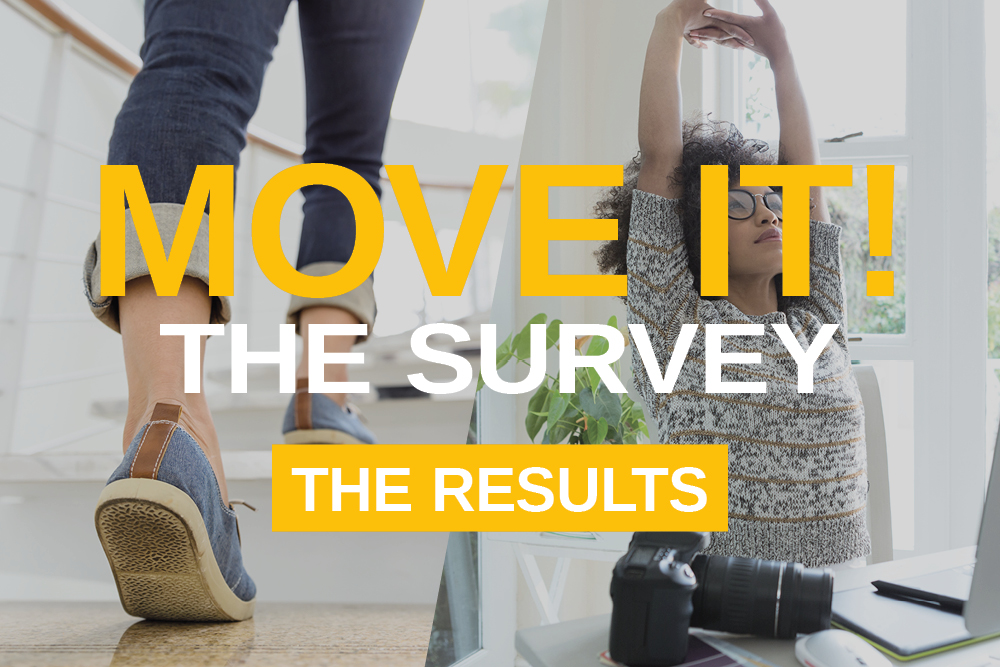
A new Posturite survey of homeworking and hybrid employees has revealed today’s working from home habits. How much do we move when homeworking, and do we take breaks from sitting at a desk?
With health, wellbeing and productivity all in mind, discover just how active or inactive homeworkers are in this report which shares all the Posturite ‘Move It!’ survey results and provides expert analysis. We explore themes including:
- Guilt people feel about being seen to be always ‘at their desk’
- How privacy at home can help us to move more
The Posturite ‘Move It!’ online survey was completed in Autumn 2023 by 576 homeworking employees. Participants are employees of businesses including Astra Zeneca, Capita, Knight Frank, M&S, Renault, Unilever and Vodafone, as well as councils, the NHS, police forces, government departments, universities and charities. Some participants have disabilities. 22% work from home full-time and 78% are hybrid workers.
Questions posed to participants included:
- Do you think you generally move enough during your homeworking days?
- Would you like to change your habits and move more frequently?
- Which work venue do you tend to be more sedentary in?
- How often do you usually move away from your desk when working from home?
- What prompts you to move when homeworking?
Let’s look at the results:
1. Do you think you generally move enough during your homeworking days?
- 33% Yes
- 67% No
2. Would you like to change your habits and move more frequently?
Of the people who think they don’t move enough:
- 87% would definitely like to change their habits and move more frequently.
- A further 12% would maybe like to.
- Only 1% wouldn’t like to move more frequently.
Professor in Physical Activity, Sedentary Behaviour and Health at the University of Leicester, Dr Charlotte Edwardson, commented on these results:
“It is encouraging to see that among those surveyed who don’t feel they move enough, nearly all want to change this behaviour. Strategies to reduce and regularly break up sitting, including when working from home, are needed and research shows that this could help to improve health and work-related outcomes.”
![]()
These homeworking and movement survey results are also presented as an infographic here.
Posturite is committed to helping people experience ‘active working’ in every location to enjoy the physical health, mental health and productivity benefits. The ergonomics experts at Posturite recommend moving away from our desks frequently and changing our tasks and posture regularly while working.
The recommendation for how much to move
Dr Charlotte Edwardson, Professor in Physical Activity, Sedentary Behaviour and Health, says:
“We recommend that people take short but frequent breaks – around every 30-60 minutes just for a few minutes – while they’re working.”
The DSE regulations from the Health and Safety Executive states that by law employers must:
“Plan work so there are breaks or changes of activity for employees who are display screen equipment users. Breaks or changes of activity should allow users to get up from their workstations and move around, or at least stretch and change posture.”
Back pain and not moving enough
Inactivity can lead to back pain, and keeping moving helps recovery and management of back pain by increasing blood flow and nutrients to the soft tissue in the back.
- 90% of the survey respondents were aware that being less sedentary can help to prevent back pain.
- 10% were unaware of the importance of moving to help prevent back pain.
Survey respondent comments included:
“I've needed physiotherapy in order to resolve back issues from being at a desk for so long every day.”
“My back appreciates it when I just get up more during the day.”
“Having had a herniated disc in the past and sciatica, I am aware that moving more can help prevent my back pain.”
Katharine Metters, Head Consultant in Ergonomics at Posturite, said:
“What was very apparent in the survey comments was that the people who are taking the most care to move frequently while working are usually the people who've already suffered back pain or other discomfort. They’re the ones actually doing the right things in terms of movement! If you're in pain, then you start to care. But sometimes it can be too late. An important part of my work is to help prevent people’s back pain.
I want to share with everyone how important it is to incorporate regular movement into our working days.”
What are the other risks of being too sedentary?
The NHS states that some cancers, heart conditions and type 2 diabetes are linked to being inactive and a sedentary lifestyle is thought to be a major threat to our health. According to the World Health Organisation, approximately 3.2 million deaths each year are attributable to insufficient physical activity, and the WHO Global Action Plan on Physical Activity includes policy recommendations to encourage more opportunities for physical activity in workplaces.
The British Heart Foundation explains why physical inactivity increases the risk of heart and circulatory diseases: being inactive can lead to fatty material building up in your arteries. If the arteries that carry blood to your heart get damaged and clogged, it can lead to a heart attack.
3. Which work venue do you tend to be more sedentary in?
“I have fewer interruptions that require me to stand and walk away from my laptop when working from home and so I can find myself not having moved properly for a couple of hours if I am focussed on the work tasks at hand. The change to working from home and the poor practices so easily slipped into are setting me, and many like me, up for a range of detrimental physical changes.”
- 58% tend to be more sedentary in the home than in the office.
- 18% tend to be more sedentary in the office than in the home.
- For 24%, it varies too much to say.
These answers reveal therefore that activity levels vary from person to person. With 18% of workers actually being more active when they work from home compared to the office, we cannot condemn working from home to the ‘bad books’ for health. We need to work hard to encourage more activity in every location.
More privacy to move when working from home
The privacy aspect working from home is one of the reasons that some homeworkers are more active at home than they are or were at the office:
“I am in private, so I don't feel awkward standing up to stretch or walk around for no apparent reason.”
“I am more mobile when working from home than when in the office, it's natural and automatic at home and requires a specific intention in the office.”
“At home I will get up and or just stretch out because I feel comfortable doing so at home but not in the office.”
Jodie Weller is a Senior DSE Assessor at Posturite which involves meeting one-to-one with workers who use computers and other Display Screen Equipment to problem-solve discomfort issues they’re experiencing, including work-related back pain. She says:
“Before Covid, many people felt they moved frequently due to working within the office, where they may have had more natural reasons to get up and move away from their desk. However, it became apparent during the transition to homeworking through lockdowns, that a number of us required some self-motivation and adjustments to our work habits, in order to combat the negative effects of sitting at a computer.
At Posturite we have always encouraged people to move before discomfort sets in, in order to try and prevent the build-up of static tension.
During DSE assessments I have conducted for hybrid and home-based workers over the past year, it has been great to hear more people autonomously bringing up the topic of regular movement during their desk-based work. To me, this has highlighted that people have naturally developed more self-responsibility when it comes to ensuring that we move our bodies, just as humans were designed to!
It is key to remember that it is our own responsibility to look after our bodies and only we can implement positive changes moving forward.”
4. How often do you usually move away from your desk when working from home?
- Every 25 minutes or less = 9%
- Every 25-50 minutes = 26%
- Every 50-80 minutes = 33%
- Every 80-120 minutes = 16%
- Every 120-180 minutes or more = 8%
- Every 3 hours or longer = 8%
Remember that moving every 30-60 minutes is recommended.
Posturite recommends one of the ways to be more active while working is to use a sit-stand desk or sit-stand platform. Standing to work for periods within the day is a win-win because people can still get their work completed but they’re increasing their activity and changing their posture.
5. What do you do to prompt more movement while working from home?

- 37% wear a fitness tracker to measure their activity
- 35% exercise during a lunch break
- 26% carry out different tasks in different positions around the home
- 18% use a sit-stand desk or sit-stand platform
- 18% use an office chair which has a movement mechanism to provide support and movement
- 14% organise their diary so that they move frequently
- 11% place items they need further away (for example in another room)
- 9% set an alarm to remind them to move
20% of those surveyed do none of the above.
“I have dogs that need to be let out regularly – this helps!”
“I try to drink plenty of fluids so I have to get up frequently to use the loo!”
“I run up and down the stairs 10 times to get the heart pumping.”
“When I have my short breaks, I do things like put a clothes wash on and time it so that it finishes in my lunch break. Or I do other quick house jobs such as to water the plants which encourages movement.”
“I work 4 days a week from home in one room so there is nowhere to move but the bathroom.”
“I move to answer the front door to the many deliveries my children have ordered!”
“I have MS and a lot of pain and discomfort in all limbs which can make movement painful and challenging. At the same time gentle, regular movement does help.”
“I don't move unless I need food, drink or a bathroom break.”
“Nothing prompts me to move - I get carried away with work.”
“I have ADHD so I do tend to move my legs and feet a bit, but not really anything else because I hyper-focus on my work for hours at a time, which I know is not healthy.”
Ellice Whyte, Business Psychologist and partner to Posturite, says she stands wearing her wireless headset to take calls, and feels much more active and creative in her calls and meetings when she can move around more freely.
Does being more active while working also benefit your mental health?
“Movement is great for your mental and cognitive health as well as your physical health” says Business Psychologist Ellice Whyte. “It enhances cognitive functions such as memory, concentration and creativity which leads to better work performance. Plus, if you’re moving regularly it can stimulate the production of endorphins which improve mood and decreases feelings of depression, anxiety and stress.”
One survey participant commented:
“I know movement is good for my mental health, so if I've had a heavy meeting or a challenging piece of work while working from home, I ensure I step away and move my body or get some air.”
Guilt at not being permanently at your desk
Without any prompting, ‘guilt’ and being ‘judged’ were common themes in the homeworking survey results. Some people said they worried they would be negatively judged by colleagues if they take short breaks from their computers and desks.
Comments included:
“I am very happy to go for a lunchtime walk when I work from the office. But when I work from home, I feel really guilty for doing exactly the same thing. I feel less comfortable stepping away from my desk as I feel like there is greater pressure to ‘prove' that I am working.”
“I used to feel a bit judged in the office for getting up every 30 minutes for a brisk walk around the building. Everyone needs to understand the productivity benefits of stepping away from your desk!”
“I let work rule me sadly and worry about not getting all my work done in time.”
“My computer goes into a locked mode after a very short time away and Teams shows you as being away which can create guilt around whether you are seen to be spending enough time at your desk.”
But as Katharine Metters from Posturite states:
“We should judge people on results, not how long they are static at their desk.”
Encourage movement and short breaks by staff
Posturite therefore puts a plea out to managers to make sure staff know that taking short breaks to move, stretch and give the eyes a break from the screen is encouraged.
With the knowledge that being inactive can lead to poor health and potential sickness absence, it would of course be counter-productive for an employer to insist on being ‘chained to a desk’ in any case.
Now see the Posturite ‘Move it!’ survey results presented as an infographic.
Thank you to each and every one of the 576 Posturite ‘Move it!’ survey participants. Every response was greatly appreciated and the comments were read in detail.
Read next:










